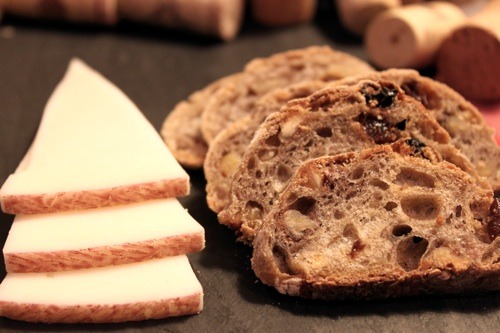The last cheese in my brief tour of Spanish cheeses, Murcia al Vino, is a pasteurized goat’s milk cheese. It is actually a pretty unique cheese, in that: although it is technically a washed rind cheese, its rind is formed with red wine instead of mold cultures; and, it is made with high quality goat’s milk, sourced from highly evolved goats.

The wine
The most recongizable feature of this cheese is that it is coated in a mahogany colored wine rind. What you probably didn’t know is that this practice is not really all that old. After reading about Murcia al Vino on Formage du Mois, I found out that this cheese is actually not “traditional.” According to the Complete Idiot’s guide to Cheeses of the World, In 1986, the local government challenged cheesemakers to make their cheese more distinctive—and have a longer shelf life—and in return, they would give this cheese a regional commercial status.
So, what the cheesemakers did, was take a traditional goat’s milk cheese called Queso de Murcia and soak it in red wine. And voila, you have a “distinctive” cheese; and, for all of you Spanish speakers, the name of this cheese appropriately changed from Queso de Murcia to Murcia al Vino. Also, because of it’s wine bath, in English, it is commonly referred to as “drunken goat cheese,” or “red wine goat cheese.”
The perfect goat
What, from the outside, looks like an ordinary goat, the Murciano-Granadina goats are quite special. Yes, the veritable X-men of goats, they have super powers for producing milk. Over centuries breeders isolated and bred goats that produced a lot of milk. Not only does the Murciano-Granadina goat have excellent milk production, but it’s also very hardy and is well suited for the hot dry Mediterranean climate. It proved too difficult to find a non-licensed image of one of these goats, but you can see one here.
Wrapping up
Murcia al Vino is pretty amazing. The richness of the milk is particularly enjoyable. The rind might be scary for the less experienced, but it’s completely edible—should you choose to eat it or not.
This cheese is a summertime treat, and is often eaten with sweet summer fruits. As you might expect, I decided to eat some in the dead of winter, so I hadn’t any of these, but it is certainly something to keep in the back of your mind. But, it’s common fair for Spanish tapas and on a cheeseboard. If you’re into wine pairing, you’ll want to first try and find a regional match. By regional match, I mean, you want to find a wine that originates from the same location as the cheese. In this case you’ll want to try to get a Spanish red wine, like Rioja or Riberia del Duero. If all else fails, go with something you know, like a Pinot Noir.